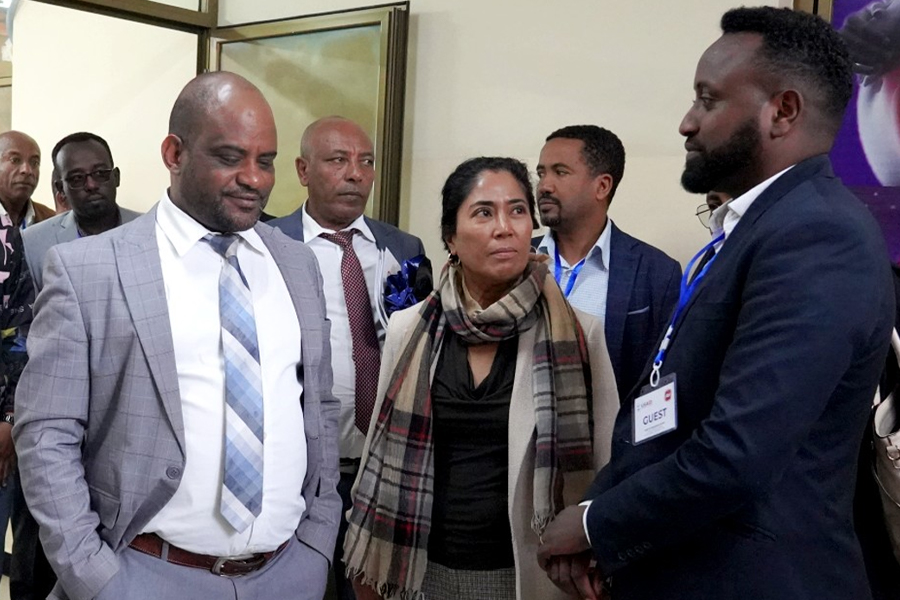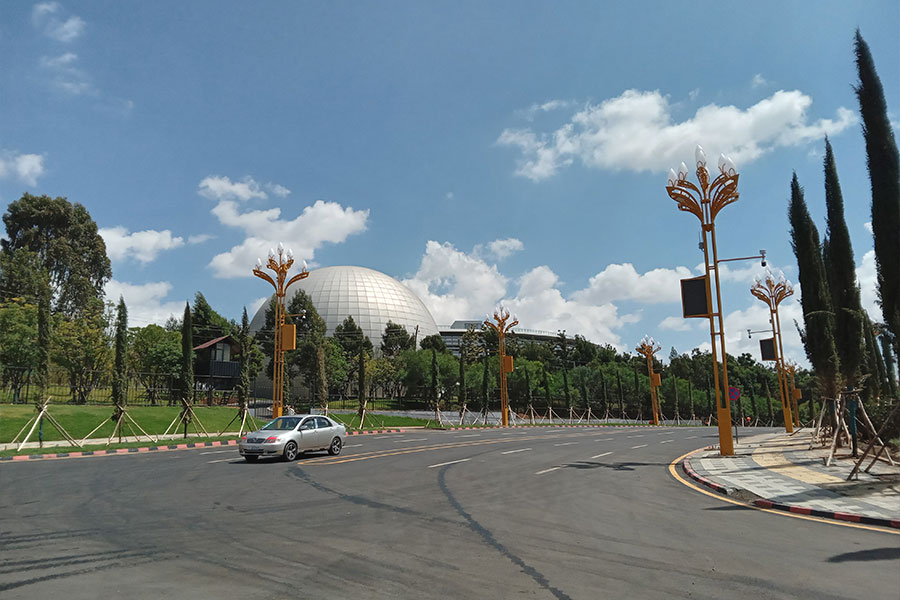
Commentaries | Dec 04,2020
Feb 18 , 2023
By Daniel Hailu (PhD)
The demographic dividend is the accelerated economic growth that can result from changes in the age structure of a country’s population such that the proportion of the working is increasingly higher than that of those who are dependent on it. This is not yet the case in Ethiopia, argues Daniel Hailu (PhD), a managing director of Litmus Research & Consultancy Plc. He can be reached at danihailu@gmail.com
Ethiopia’s population size of approximately 54pc and 46pc are younger than 18 and 15 years of age, respectively, significantly depending on the remaining small productive population. The consequent high dependency ratio has dissuaded significant savings and investments necessary for rapid economic growth.
The demographic dividend is not a natural outcome of population growth or rapid urbanisation. Nor is it automatic. It depends on whether Ethiopia takes integrated, sustained and simultaneous measures on critical fronts. One, if not the most important, is gender equality and women’s empowerment.
Women are among the principal stakeholders in critical actions that need to be taken to spur demographic transition and reap its dividend, including delaying marriage, reducing unwanted pregnancy, and promoting children’s physical and psychosocial health and cognitive development. No less vital are their education and training.
Much progress that Ethiopia has made towards gender equity and women empowerment over the past two decades has concentrated mainly on revising old laws and instituting policies and strategies. This is not to deny practical measures were taken to promote this agenda. It is to emphasise that there is much to be desired when considering the level of investment needed if such empowerment is to steer demographic dividend.
Ethiopia does not have an overarching policy framework for social development, of which empowering these demographic segments could have been a critical pillar. This is quite unlike policymaking in the economic sector, guided formerly by agricultural development-led industrialisation (ADLI) and currently by the Homegrown Economic Reform Agenda (HERA). These overarching economic policy frameworks have identified and prioritised broad economic development issues and challenges, elaborated in specific economic policies such as agriculture and industry.
The blueprints have rationalised the contributions and complementarities of specific economic policies in generating development outcomes. They have facilitated systematic and ongoing reviews and evaluations of the coherence and integration among various economic policies, strategies and action plans by designated entities at the highest level of government, such as the federal macroeconomic team that the Prime Minster convenes.
This enabled a feedback loop that reduced potential policy redundancy and fragmentation. It provided the basis for adapting the economic policy environment to changing local and global circumstances, helping Ethiopia’s economy to demonstrate sustained growth and resilience.
Had Ethiopia defined and implemented a well-thought blueprint for social development similarly, we could have witnessed an even higher economic growth rate. We could have reduced the alarming disparity between the poor and the riches and protected women’s human rights and vulnerable groups.
In the absence of such a blueprint, social policymaking in general and policymaking related to gender equity and women’s empowerment have been haphazard and reactive to currently perceived situations. They have resulted in fragmentation, incoherence, and redundancy in the social policy space. It has also created policy vacuums on social issues critical to realising the demographic dividend, such as unpaid care work.
The most to suffer from this chaotic social policymaking environment are often referred to as “cross-cutting issues” such as women and gender empowerment, social protection and population. They have obtained much less systematic thinking, political commitment and budgetary allocations.
Ethiopia has been implementing gender mainstreaming, a global gold standard for ensuring the specific needs of men and women are taken into account in developing policies and implementation of strategies. While public offices should mainstream gender in their services within their mandate, they should also set their standards.
Unfortunately, however, gender mainstreaming in public institutions suffers at least three core challenges due to the absence of a social policy framework.
First, Federal and regional agencies suffer from severe human, technical, financial and technological constraints. Secondly, the federal ministry and regional bureaus mandated to oversee gender mainstreaming are like a toothless lions, having the responsibility but no legal authority to hold public offices accountable. Thirdly, the political commitment of the leadership of the various ministries and bureaus varies, most giving peripheral to no attention to mainstreaming the empowerment issues in their interventions.
Gender equity and women empowerment issues have supply and demand side barriers, which are conceptually distinct but mutually reinforcing.
On the supply-side barriers, there is the absence of a blueprint for social development and the consequent poor practice in gender mainstreaming. Demand-side barriers reside within individual women and men in their interpersonal relationships and unjust community values and practices hindering women’s and girls’ uptake of available resources and opportunities. They also expose them to risks such as gender-based violence and harmful traditional practices.
It appears that the federal government has adopted gender mainstreaming to address both supply and demand side barriers to the empowerment agenda if we judge its faith from the reflections of Fistum Assefa (PhD), who spoke on “Our People – Our Capacity” panel organised by the Prime Minister’s Office in January this year. When gender mainstreaming is implemented effectively, it can indeed contribute to transforming the demand-side barriers.
However, it falls short of addressing demand-side barriers outside sector ministries' technical capacity and mandates.
Take, for example, the statistically significant gender difference the Ministry of Education reported on the performance of students who sat for last year’s high school leaving examination.
The Ministry is mandated to address and is accountable for the limited gender mainstreaming in the school system, which may have contributed to the difference. However, it has a little sphere of influence over much of the cause for the difference in individuals, households, and communities. Chief among these are social norms that place a disproportionate work burden on girls, forcing them to be frequently absent or late, depriving them of after-school time for school-related activities.
International experience shows that effectively addressing the demand-side barriers to the empowerment agenda requires high technical and technological capacity. It also demands effectively implementing a comprehensive social and behavioural change communications strategy that uses appropriate mediums to reach social segments at all levels with relevant messages.
However, in the absence of a blueprint for social development, there appears to exist little political commitment to build the capacity of the Ministry that is mandated. There is little coherence and integration among social and behavioural interventions and no effective mechanism for learning about the effectiveness of models adopted by several actors.
Ethiopia’s prospect for reaping the population dividend can be measured partly by how much more and how soon it invests in the normal physical, psychosocial and cognitive development of its male and female children. Unleashing its girls and women from unpaid care work so that they can sufficiently prepare for and join the labour force is also another yardstick.
Developed countries enjoying equitable social and economic development, such as the Scandinavians, had started investing in their women and girls decades before their Gross Domestic Product (GDP) began to grow. The former had contributed significantly to the latter.
Ethiopia needs to invest in three high outputs to optimise the empowerment interventions to the demographic dividend: a blueprint for social development that rationalises the critical role of empowerment; addresses challenges of gender mainstreaming in the supply side; and, defines and implements a national flagship program to transform demand-side barriers. These outputs can generate equality, representation and meaningful participation and fight gender-based violence.
Failure to realise the empowerment agenda may turn a window of opportunity for the demographic dividend into a demographic disaster. The proportion of the unemployed dependent on the working population continues to increase, undermining savings and productive investments. According to the 2021 Ethiopian Labour & Migration Survey, the female workforce unpaid in the care work sector comprises 45.3pc.
The unemployed labour force will resort to illegal means of survival, eventually fueling social tension and instability to succumb to societal breakdown.
PUBLISHED ON
Feb 18,2023 [ VOL
23 , NO
1190]


Commentaries | Dec 04,2020

Radar | Jun 30,2024

Fortune News | Aug 13,2022

Radar | Oct 12,2024

Fortune News | Aug 27,2022

Radar | Feb 22,2020

In-Picture | Feb 03,2024

Advertorials | Apr 08,2024

Radar | Dec 08,2024

Commentaries | Apr 22,2022

My Opinion | 131772 Views | Aug 14,2021

My Opinion | 128157 Views | Aug 21,2021

My Opinion | 126101 Views | Sep 10,2021

My Opinion | 123723 Views | Aug 07,2021

Dec 22 , 2024 . By TIZITA SHEWAFERAW
Charged with transforming colossal state-owned enterprises into modern and competitiv...

Aug 18 , 2024 . By AKSAH ITALO
Although predictable Yonas Zerihun's job in the ride-hailing service is not immune to...

Jul 28 , 2024 . By TIZITA SHEWAFERAW
Unhabitual, perhaps too many, Samuel Gebreyohannes, 38, used to occasionally enjoy a couple of beers at breakfast. However, he recently swit...

Jul 13 , 2024 . By AKSAH ITALO
Investors who rely on tractors, trucks, and field vehicles for commuting, transporting commodities, and f...

Jul 5 , 2025
Six years ago, Ethiopia was the darling of international liberal commentators. A year...

Jun 28 , 2025
Meseret Damtie, the assertive auditor general, has never been shy about naming names...

Jun 21 , 2025
A well-worn adage says, “Budget is not destiny, but it is direction.” Examining t...

Jun 14 , 2025
Yet again, the Horn of Africa is bracing for trouble. A region already frayed by wars...

Jul 6 , 2025 . By BEZAWIT HULUAGER
The federal legislature gave Prime Minister Abiy Ahmed (PhD) what he wanted: a 1.9 tr...

Jul 6 , 2025 . By YITBAREK GETACHEW
In a city rising skyward at breakneck speed, a reckoning has arrived. Authorities in...

Jul 6 , 2025 . By NAHOM AYELE
A landmark directive from the Ministry of Finance signals a paradigm shift in the cou...

Jul 6 , 2025 . By NAHOM AYELE
Awash Bank has announced plans to establish a dedicated investment banking subsidiary...